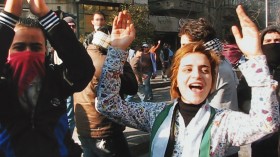The time of year has come to bid you welcome to the fifteenth edition of the festival, to this jubilee edition that we so tirelessly and passionately worked on in order to bring you all a rich and varied program, details of which you’ll find in the pages that follow. Passion was what actually brought us from a small, three-day, one-venue event to this 10-day full-blown celebration of cinema and music, of arts and culture. All of this happens in a small corner of the world, in a country still shaken from its turbulent past, one continuing to struggle with endemic corruption that is threatening the very future of its citizens.
So no wonder Corruption is the main theme of the festival this year and will be highlighted in many different forms and across many festival sections: a specially curated film program entitled Power, Corruption and Lies; debates and panel discussions; children’s plays, and many other events will address this worldwide, cancer-like phenomenon. Once again our dear friend and Bafta-winning filmmaker Daniel Mulloy has created another striking visual campaign to match the theme of the festival.
As we were putting the finishing touches on our most ambitious program to date, news of yet another deadly shooting and terrorist attack is occupying our news feeds, making fear, seemingly, the only constant of this world. Therefore it is not surprising that several films from this year’s selection reflect upon this.
We’ll be showing films about mass shootings and the rapidly-
growing police militarisation in the US; wars and its atrocities in the Middle East and elsewhere in the world; films about people desperately trying to flee to Europe; and, films about that same Europe, confused and in disbelief as to how to cope with it all. We will also be showing a film about Al-Qaeda suicide bombers in Syria as they’re trying to blow themselves and others up, as we’ll show films about corrupt politicians and crazed dictators.
The fact that documentary filmmakers were there to film all these stories and to bring them back to us is yet another testament to one of the most difficult, dangerous, and noblest professions out there, added reason for us to continue championing and celebrating these films at our festival.
Across six competition categories, you’ll find many films that are dear to our hearts and which we are proudly sharing with you. Our collection of directors includes renowned filmmakers, as well as fresh exciting talents that we’re keen to follow and whose work we’re so eager to share.
We are continuing to bring the fruits of our training programs to you in the form of five films produced under our own Future is Here banner. There are six more made with our regional partners Pravo Ljudski and MakeDox festivals under the banner of Active Creative Documentary School. And there are another half dozen made in collaboration with our partners from France, Pistes Solidaires Méditerranée. One can feel nothing but pride about all this, as most of the films were shot in Prizren and elsewhere in Kosovo, somehow echoing my words from last year’s welcome note about putting Prizren on the map of cities where films are not only being screened, but also made.
We are happy beyond words to welcome back to DokuFest acclaimed Irish photojournalist, filmmaker, and dear friend, Seamus Murphy, whose work will be presented across the festival in the form of the main photo exhibition at DokuPhoto, which features his collaboration with British musician and artist PJ Harvey. There will also be a special event screening of his films and music videos, providing a truly great come back after the visit he and Harvey made to the festival five years ago.
We’re thrilled to welcome our partner festivals from North South Documentary Network with a selection from each of them, thus offering a window through which to glimpse films coming from Mexico, Ecuador, and the US.
The festival will pay tribute to two great masters of cinema, both of whom passed away recently. Chantal Akerman and Abbas Kiarostami as we feature special screenings of some of their films. A restored version of Jean Dielman, 23 Commerce Quay, 1080 Brussels will be shown along with No Home Movie, Akerman’s final film. An interview with Chantal Akerman, filmed during her visit to Kosovo in November of 2014 by Bosnian artist and filmmaker Ibro Hasanovic, will also be shown. To remember the great Iranian filmmaker Abbas Kiarostami, who passed away less than a month ago, we will screen two of his landmark films, Taste of Cherry and Close Up.
We invite you all to experience these and many other offerings from this year’s program and hope that while doing so you’ll be rewarded as much as we were while preparing it.
Our heartfelt gratitude goes to all the extraordinary people that have made this beautiful journey and this dream of ours possible: our partners, generous sponsors, our wonderful volunteers, and the filmmakers who shared their films with us. But the biggest thanks we give to all of you, our beautiful and faithful audiences.
I wish you a great festival!
Veton Nurkollari
Artistic Director



